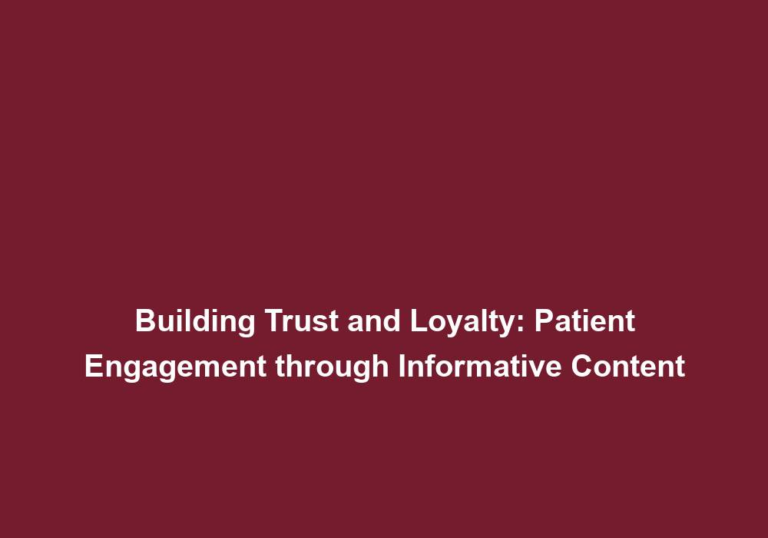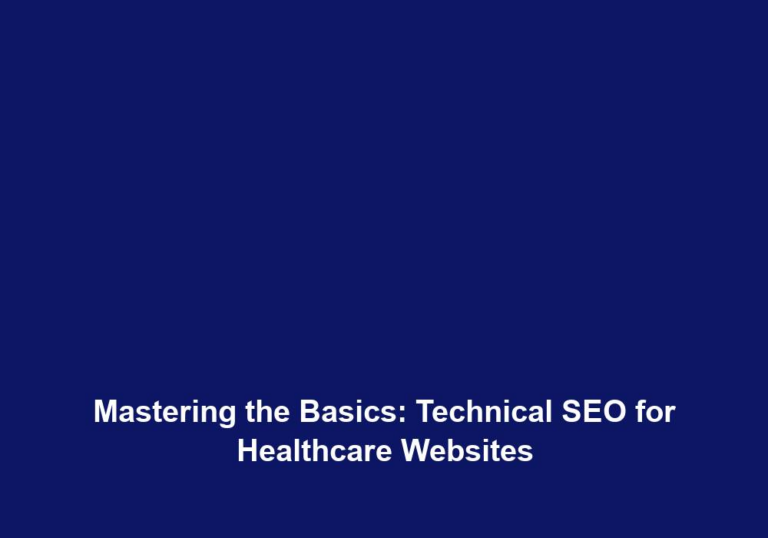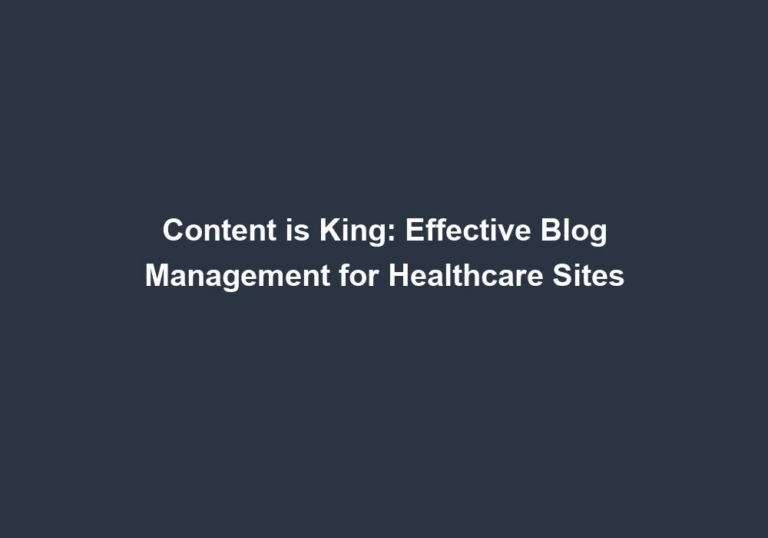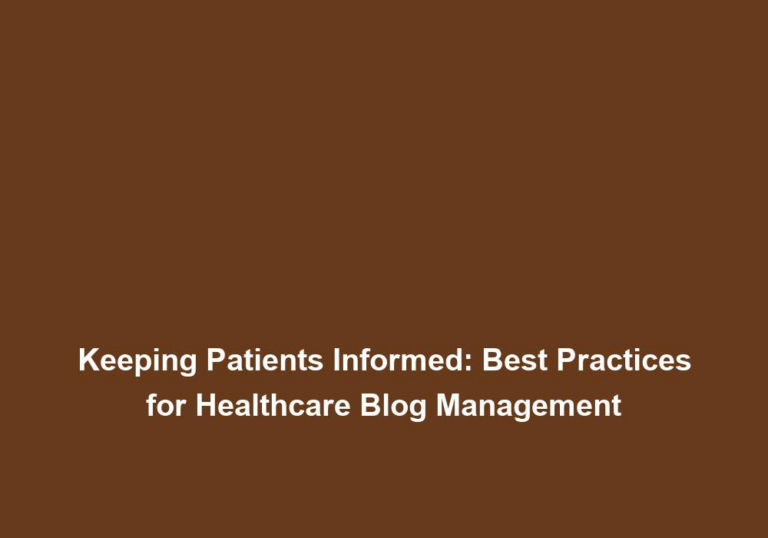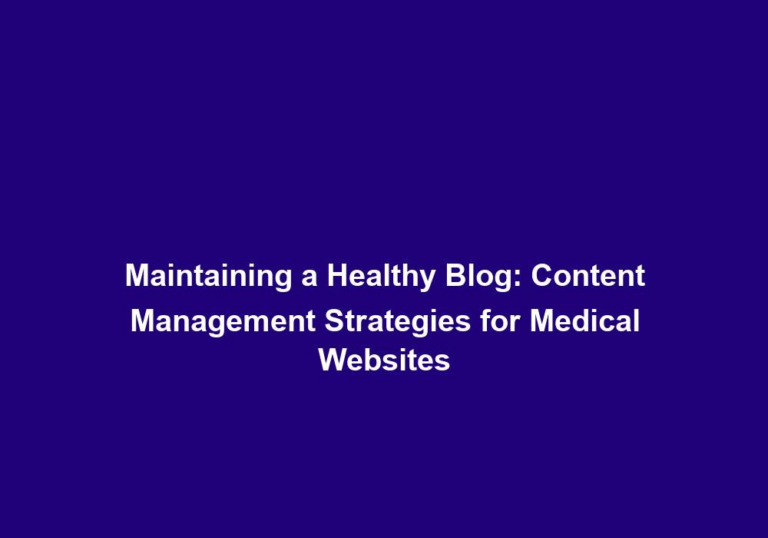Stay Relevant: Fresh and Informative Medical Blog Post Ideas
In the fast-paced world of healthcare, it is crucial for medical bloggers to stay on top of the latest trends and provide readers with valuable, up-to-date information. Creating fresh and informative blog posts is not only important to engage your audience but also to establish your authority as a knowledgeable source in the medical field. In this article, I will share some unique and compelling medical blog post ideas that will help you stay relevant and attract a wider readership.
1. Exploring Cutting-Edge Medical Technologies
Introduce your readers to the latest advancements in medical technology. Write a blog post about a newly developed device, treatment, or procedure that has the potential to revolutionize healthcare. Explain the science behind it, its benefits, and any limitations it may have. You can interview experts in the field or share success stories from patients who have benefited from these technologies.
- Provide a detailed explanation of the specific technology, device, treatment, or procedure you are discussing.
- Highlight the potential impact it can have on the medical field and patient outcomes.
- Discuss the scientific principles and mechanisms behind the technology, making it understandable for readers without a medical background.
- Include any relevant research studies or clinical trials that support the effectiveness of the technology.
- Address any potential drawbacks or limitations of the technology, such as cost, accessibility, or ethical considerations.
2. Debunking Medical Myths
Address common misconceptions or myths related to health and medicine. Write a blog post that dispels these myths using scientific evidence and expert opinions. For example, you can discuss the truth behind popular beliefs like cracking your knuckles causes arthritis or eating carrots improves your vision. By providing accurate information, you can help your readers make informed decisions about their health.
- Identify and explain the specific medical myth you are debunking.
- Present scientific evidence and research studies that contradict the myth and support the correct information.
- Provide expert opinions and quotes from healthcare professionals or specialists in the field.
- Use real-life examples or case studies to illustrate the consequences of believing in the myth.
- Offer practical tips or alternative strategies that readers can follow instead of relying on the debunked myth.
3. Mental Health Awareness
Mental health is an essential aspect of overall well-being. Dedicate a blog post to raise awareness about mental health conditions, such as anxiety, depression, or bipolar disorder. Discuss the symptoms, available treatment options, and coping strategies. Share personal stories or case studies to make the content relatable and engaging.
- Begin by explaining the importance of mental health and its impact on overall well-being.
- Define and describe the specific mental health condition you are focusing on.
- Discuss the common symptoms and signs that individuals may experience.
- Provide an overview of evidence-based treatment options, including therapy, medication, or alternative approaches.
- Offer practical coping strategies and self-care techniques that readers can incorporate into their daily lives.
- Share personal stories or testimonials that highlight the challenges and successes of individuals dealing with mental health conditions.
4. Healthy Lifestyle Tips
Share practical tips for maintaining a healthy lifestyle. Write a blog post that provides insights on nutrition, exercise, sleep, stress management, and other factors that contribute to overall wellness. Include evidence-based advice and recommendations from healthcare professionals. You can also suggest healthy recipes, workout routines, or relaxation techniques to empower your readers to make positive changes in their lives.
- Discuss the importance of adopting a healthy lifestyle for maintaining overall well-being.
- Provide practical tips and strategies for healthy eating, including portion control, balanced meals, and the importance of hydration.
- Highlight the benefits of regular exercise and recommend specific types of physical activities suitable for different fitness levels.
- Offer guidance on improving sleep quality, managing stress, and practicing self-care.
- Include evidence-based information on the impact of lifestyle choices on long-term health outcomes.
- Provide recipes, meal plans, or exercise routines that readers can easily follow to incorporate healthy habits into their daily routine.
5. Health and Wellness for Specific Groups
Tailor your blog posts for specific groups within your audience. For instance, you can write about women’s health issues, children’s healthcare, or senior citizen wellness. Address the unique challenges faced by these groups and provide tips, preventive measures, and treatment options that cater to their specific needs.
- Choose a specific group within your target audience and explain why addressing their health concerns is important.
- Discuss the unique challenges and health issues faced by this group.
- Provide practical tips and recommendations for maintaining health and wellness.
- Address preventive measures and screenings specific to the health needs of this group.
- Include information on common health conditions or diseases that affect this group and their available treatment options.
- Highlight any specific resources, support groups, or organizations that cater to the health needs of this group.
6. Preventive Healthcare
Emphasize the importance of preventive care in maintaining good health. Write about preventive measures, such as vaccinations, regular check-ups, screenings, and healthy habits, that can help prevent diseases and promote well-being. Encourage your readers to take an active role in their healthcare by being proactive and adopting preventive strategies.
- Explain the concept of preventive healthcare and its significance in reducing the burden of diseases.
- Provide a comprehensive list of preventive measures, including vaccinations, regular health check-ups, and recommended screenings.
- Explain the benefits and effectiveness of each preventive measure in reducing the risk of specific diseases or conditions.
- Address common misconceptions or concerns related to preventive healthcare.
- Offer practical tips and guidance on how readers can incorporate preventive measures into their daily lives.
- Highlight the long-term health benefits of engaging in preventive healthcare practices.
7. Health Education for Common Conditions
Choose a prevalent medical condition and create an educational blog post around it. Whether it’s diabetes, hypertension, asthma, or allergies, provide detailed information about the causes, symptoms, and available treatment options. Explain how lifestyle modifications and medication adherence can help manage these conditions effectively.
- Select a specific medical condition that is prevalent and relevant to your audience.
- Provide a comprehensive overview of the condition, including its causes, risk factors, and symptoms.
- Explain the importance of early detection and diagnosis for effective management.
- Discuss evidence-based treatment options, including lifestyle modifications and medications.
- Offer practical tips and strategies for managing the condition on a daily basis.
- Address any potential complications or long-term effects of the condition.
- Provide additional resources or references for readers to seek further information or support.
8. Healthcare Innovations Around the World
Explore healthcare innovations from different countries. Write a blog post highlighting unique healthcare systems, successful public health initiatives, or groundbreaking medical research from around the globe. Showcase how these innovations can inspire positive changes in healthcare practices worldwide.
- Research and identify notable healthcare innovations from different countries or regions.
- Discuss the specific innovation, its purpose, and the problem it aims to solve.
- Provide examples of successful implementation and the impact it has had on healthcare outcomes.
- Highlight any challenges or obstacles faced during the implementation process.
- Discuss the potential implications and lessons that can be learned from these innovations.
- Explore how similar approaches or adaptations can be implemented in different healthcare settings or countries.
- Address the potential benefits and limitations of adopting these innovations on a larger scale.
9. Medical Career Advice
Cater to aspiring healthcare professionals by offering career advice and insights. Write blog posts that cover topics such as choosing a medical specialty, tips for medical school applications, interview preparation, and work-life balance in the medical field. Share personal experiences or interview professionals to provide valuable guidance to your readers.
- Share your personal journey or interview professionals in the medical field to provide insights into different medical specialties.
- Discuss the factors to consider when choosing a medical specialty, including personal interests, lifestyle, and future job prospects.
- Provide tips and strategies for successful medical school applications, including personal statements and interview preparation.
- Address the challenges and rewards of a career in healthcare, including work-life balance and burnout prevention.
- Offer guidance on professional development, continuing education, and networking opportunities in the medical field.
- Provide resources or references for readers to explore further career-related information or support.
10. Addressing Current Health Crises
Stay up-to-date with current health crises or outbreaks and provide valuable information to your readers. Write blog posts that address concerns, provide accurate information, and offer practical tips for prevention and management. You can also discuss the impact of these crises on mental health or highlight inspiring stories of healthcare workers on the frontlines.
- Monitor and stay informed about ongoing health crises or outbreaks that are relevant to your audience.
- Provide accurate and up-to-date information on the nature of the crisis, its causes, and preventive measures.
- Address common concerns or misconceptions related to the crisis and provide evidence-based explanations.
- Offer practical tips and strategies for prevention, including hygiene practices, social distancing, and vaccination information.
- Discuss the potential impact of the crisis on mental health and provide resources for seeking support.
- Share inspiring stories or examples of healthcare workers or organizations making a positive impact during the crisis.
- Foster a sense of community and solidarity by encouraging readers to share their experiences or support one another.
In conclusion, staying relevant as a medical blogger requires continuous effort to provide fresh and informative content to your readers. By exploring cutting-edge medical technologies, debunking myths, promoting mental health awareness, sharing healthy lifestyle tips, and addressing specific healthcare needs, you can establish yourself as a trusted source of information. Remember to use headings, lists, and bullet points strategically to enhance readability and engagement. Happy blogging!



